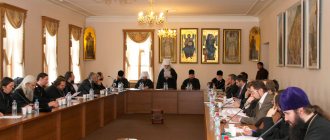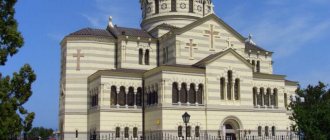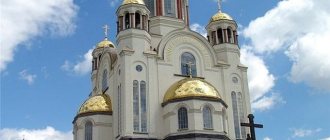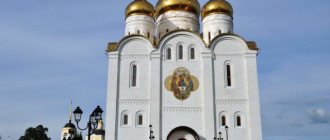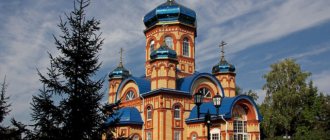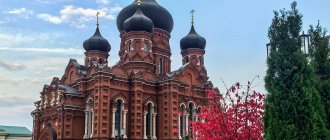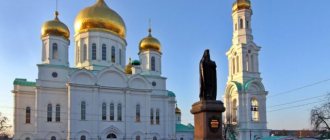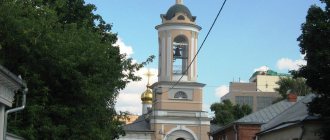The shrines of the Barnaul diocese have shown miracles more than once. Claudia Burachevskaya (niece of the nun of the Mother of God of Kazan Monastery) talks about the St. Nicholas source:
“The baby, crooked from birth, immersed in the water of the spring by the abbess of the monastery, Abbess Mariamne, suddenly began to cry and straightened his arms and legs.”
The Altai “crying” icon of the Mother of God “Quench my sorrows” also did not go unnoticed - tears appeared on the cheeks of the Most Pure Virgin during the fighting in Syria and Ukraine.
Intercession Cathedral, Barnaul, Altai Territory
| Barnaul diocese | |
| Ruling bishop | Metropolitan of Barnaul and Altai Sergius (Ivannikov) |
| Cathedral Church | Intercession Cathedral |
| Website of the Barnaul diocese | altai-eparhia.ru |
| Number of parishes | 266 |
| Number of deaneries | 3 |
| Cathedral City | Barnaul |
| Geographical location | Altai region |
| Senior management | Altai Metropolis |
Departments and commissions of the Barnaul diocese
| Department/commission | Headed by | Contacts |
| Information department | Priest Dmitry Nikitin | 8 |
| Department for Interaction between Church and Society | Archpriest Vladimir Matusov | 8-913-229-73-12 |
| Missionary department | Priest Dionisy Tarchukov | 8-905-928-35-34 |
| Department of Church Charity and Social Service | Archpriest Mikhail Ben | 8-913-213-64-15 |
| Department for Cooperation with the Armed Forces and Law Enforcement Agencies | Archpriest Andrey Ushakov | 8 (38595) 7-31-29 |
| Department for interaction with the Cossacks | Priest Oleg Golubitskikh | 8 |
| Prison Ministry Department | Priest Alexander Pobedinsky | |
| Department for Monasteries and Monasticism | Hieromonk Filaret Berdnikov | 8 |
| Department of Religious Education and Catechesis | Archpriest Sergius Fisun | 8, 8 |
| Department for Youth Affairs and Orthodox Youth Organizations | Priest Alexander Mikushin | 8-903-073-53-73 |
| Commission for Culture | Protodeacon Vladimir Chernykh | 8-923-712-99-82 |
| Commission on Family Issues, Protection of Motherhood and Childhood | Archpriest Mikhail Ben | 8-913-213-64-15 |
| Appointment commission | ||
| Award commission | Priest Dionysius Reim | |
| Board of Trustees | Priest Konstantin Alekseev | 8 |
| Theological Commission | Archpriest Evgeny Eliseev | 8 |
| Architectural-Construction-Restoration Commission | Archpriest Georgy Kreydun | |
| Commission for the Canonization of Saints | Priest Alexander Devyatykh | 8, 8 |
| Legal service | Archpriest John Melnikov | 8 |
Orthodoxy in Altai originated with the first Russian settlers at the beginning of the 18th century
The Orthodox faith in the Altai region spread with the first Russian inhabitants. In the 18th century, the first wooden churches and chapels appeared in Altai. They were erected in the Beloyarsk fortress in honor of the Apostle Peter, in the city of Barnaul in honor of the Apostle Paul and in the village of the Kolyvan plant in honor of the Resurrection of Christ.
1774
this year the first stone cathedral was built in the Altai region
All Altai churches were under the control of the Tobolsk diocese. The first stone cathedral in the Altai region was built in 1774 in the city of Barnaul. The cathedral was named Peter and Paul Cathedral.
In 1830, the Monk Macarius Glukharev organized the Altai Spiritual Mission
The Altai spiritual mission was organized by the Monk Makarii Glukharev in 1830.
Reverend Macarius Glukharev became famous not only for his work in the Altai spiritual mission, but also for his work “Thoughts on ways to successfully disseminate
The main goal of the mission was to spread Orthodoxy in Altai. At the head of the spiritual mission were: St. Macarius Glukharev, St. Macarius Nevsky, Archpriest Stefan Landyshev, Archbishops Vladimir Petrov and Innokenty Sokolov.
The organizers of the spiritual mission were helped by revered preachers - Archpriests Mikhail Chevalkov, Vasily Postnikov, Vasily Verbitsky and others.
In 1917, the Altai spiritual mission included:
- 31 departments;
- 434 Orthodox settlements, numbering about 47,000 baptized residents of Altai;
- 600 parishes;
- 84 schools that educated three and a half thousand children;
- 2 schools: missionary Biysk catechetical and Barnaul theological;
- 4 monasteries: Nikolsky women’s monasteries in the Altai Mountains and Tikhvinsky in Biysk, Chulyshmansky men’s monasteries and the largest in the district, the Bogoroditsa-Kazansky convent, where approximately 300 nuns lived;
- Icon-painting and painting workshops.
Monasteries
- Barnaul Znamensky (female)
- Sorochelozhsky St. John the Baptist monastery, bishop's metochion
Previously subordinate dioceses
- Aleisky Dimitrievsky (male, now within the Rubtsovsk diocese)
- Kamensky Epiphany (female, now within the Slavgorod diocese)
- Korobeinikovsky Kazansky (male, now within the Rubtsovsk diocese)
- Yarovskaya Ksenia-Pokrovsky (female, now within the Slavgorod diocese)
The Bolsheviks destroyed the Altai spiritual mission in 1917
1908
this year the Barnaul Vicariate was established
In 1834, the lands and churches of the Altai Territory began to be included in the Tomsk diocese. In 1908, the Tomsk diocese established the Barnaul Vicariate (several church parishes that were governed by a vicar on behalf of the bishop in power).
In 1917, the Altai spiritual mission ceased. Most parishes and church schools were closed. In the 1920-30s, the Bolsheviks ravaged and partially destroyed all the monasteries, chapels and departments. From 600 parishes today there are 3 left:
- Intercession Cathedral (Barnaul).
- Assumption Cathedral (Biysk).
- Arkhangelsk Church (Rubtsovsk).
In 1930, an independent Barnaul diocese was organized, headed by Bishop Alexander Bialozar.
1938
this year the diocese is being liquidated due to persecution
In 1938, the diocese was liquidated due to the Bolshevik persecution of the church. The territory of the Barnaul diocese was transferred to the Novosibirsk diocese until 1994.
Archpastors
Barnaul Vicariate of the Tomsk Diocese
- Meletius (Zaborowski) (November 21, 1908 - February 23, 1912)
- Evfimy (Lapin) (March 18, 1912 - January 26, 1916)
- Gabriel (Voevodin) (January 26, 1916 - 1919)
- Victor (Bogoyavlensky) (1919 - 1923)
- Nikodim (Shatunov) (1923 - 1924)
- Nikodim (Voskresensky) (December 4, 1924 - 1925)
- Vladimir (Yudenich) (April 2, 1927 - November 28, 1933)
Barnaul diocese
- Alexander (Bialozor) (1930 - ?)
- Sschmch. Herman (Kokkel) (September 1931 - October 1932)
- Tarasy (Livanov) (December 1931 - 1932)
- Sschmch. Jacob (Maskaev) (April 4, 1933 - February 11, 1937) [6]
- Sergius (Vasilkov) (1936 - 1937) supreme, archbishop. Novosibirsk
- 1938 - 1994 - not replaced
- Tikhon (Emelyanov) (July 8, 2001 - January 20, 2002) supreme, archbishop. Novosibirsk
At the end of the 80s of the twentieth century, the revival of Orthodoxy began in Altai
At the end of the 80s of the 20th century, the Orthodox faith began to revive in the Altai region. At this time, the territory of the Altai Territory was under the leadership of the chief bishop of the Novosibirsk and Barnaul diocese, Bishop Tikhon.
The visit of His Holiness Patriarch of Moscow and All Rus' Alexy II to Barnaul in 1991 played an important role in the resurrection of Orthodoxy in the Altai region. After the visit of Alexy II, the believers of the Altai Territory were returned to St. Nicholas Church, Znamensky Church, and churches named after St. Dmitry of Rostov.
On February 26, 1994, by resolution of the Holy Synod, the independent Barnaul diocese was revived.
Chief Bishop Tikhon of the Novosibirsk and Barnaul diocese in the late 80s of the twentieth century
The Barnaul diocese has its own media, a theological seminary, and charitable organizations
In December 1997, a Theological School with a psalm department was opened in Barnaul, and in 2004 the construction of new buildings was completed.
In 2006, the School acquired the status of a seminary. In 2010, a Theological and Catechetical School opened in the Barnaul diocese, which was named after St. Macarius, Metropolitan of Moscow.
2010
this year the Theological and Catechetical School named after St. Macarius began its work
Charity occupies a special place in the Barnaul diocese. The shelter named after St. Olga Equal to the Apostles and the Mother and Child charity organization everywhere help mothers with young children who, for one reason or another, have been left homeless.
Since 1996, the publishing department of the Barnaul diocese has been publishing the printed newsletter “Altai Mission,” which publishes materials about church life and articles about the history of the Altai Mission.
Geography of deaneries
- Barnaulskoye - Barnaul
- Novoaltaysk, s. Cosija
- Beloyarskoe (Pervomaisky, Talmensky districts)
- Beloyarsk village, village Bayunovskie Klyuchi, p. Berezovka, village Bobrovka, village Borovikha, s. Zhilino, s. Zhuravlikha, s. Zudilovo, Kislukha village, village. Kurochkino, s. Larichikha, Lesnoy village, village. Logovskoye, s. Lugovoe, village Nalobikha, Novoaltaysk, Ozerki village, village. Pervomayskoe village Povalikha, Sannikovo, Severny village, ZATO Sibirsky, village. Talmenka
- Zarinsk, s. Antipino, s. Verkh-Kamyshenka, Golukha village, village. Gonoshikha, s. Dmitro-Titovo, s. Dumchevo, village Zhulanikha, s. Zalesovo, village Cordon, s. Kytmanovo, s. New Taraba, village. Novodrachenino, s. Novozyryanovo, village Novokokorskoe, village Novoozernoe, village Peshcherka, village Semeno-Krasilovo, village. Sosnovy Log, village. Srednekrasilovo, village Staroglushinka, village Togul, s. Khmelevka, s. Shatunovo
Interesting facts about the Barnaul diocese
The miraculous healing spring is located in the mountainous region of Barnaul
St. Nicholas Spring is known throughout Russia. According to legend, a pious Barnaul Christian was given:
“...to see, as it were, a pillar of fire from earth to heaven, and in that pillar he saw St. Nicholas the Wonderworker.
He came up and saw: a spring was gushing out of the ground. He realized that this was not without reason. This spring of God-sanctified water is given to the city of Barnaul through the prayers of Nicholas
The Wonderworker for the healing of the sick and the glorification through the healings given of the One in the Trinity, glorified God, His great Saint Nicholas.”
Nicholas the Wonderworker, after whom the spring near the monastery in Altai is named
The spring was named St. Nicholas in honor of St. Nicholas the Wonderworker, and next to the spring a bathhouse was built, to which in pre-revolutionary times sick people from all over Russia came for healing.
In 1921, a convent near the holy spring was turned into a pre-trial detention center, and a landfill was organized on the site of the St. Nicholas spring. From 1921 to 1995, the holy spring flowed through mountains of garbage.
In 1995, the territory where the St. Nicholas spring was located was cleared and water was taken for laboratory research.
The results of this analysis surprised even the experts: the water from the miraculous source met all “drinking” standards.
St. Nicholas spring after restoration
“Crying” icon of the Mother of God “Assuage my sorrows” during hostilities
The appearance of the revered icon in the temple was due to a miraculous accident:
“One day a fisherman comes to us and says:
“Today I was fishing, I saw an icon floating not far from the shore - in a backwater on Chumysh. I caught it and brought it to you.”
We dried it, restored it a little and placed it in the center of the temple."
Andrey Ushakov
archpriest
— says Archpriest Andrei Ushakov.
The first miracle happened to the icon in 1999. On the eve of the Feast of the Presentation of the Lord, the icon “buried.” The clergy handed over the icon to experts for investigation of the unusual phenomenon.
The commission's report was as follows:
“The new icon of the Mother of God, made in Sofrino, is inserted into a frame - under glass.
The image is multi-colored, executed lithographically on paper, and this paper is glued to a chipboard.
The icon is closed almost hermetically... The wall on which the icon hangs is dry.
Under all the above circumstances, on the front side of the icon, traces of leaks of a liquid substance are clearly visible through the glass...
There are more than ten places of leakage and leakage...
The icon was taken out of the frame for a closer examination.
At the same time, traces of dried stains, as if from water, were even more clearly found on the surface of the icon.
Especially on the surface of the face of the Most Pure Lady - the right cheek - there are, as it were, traces of tears.”
Also, according to eyewitnesses, the “tears” of the Mother of God could be seen during the bombing in Syria and during the days of the military conflict in Ukraine.
Barnaul Theological Seminary
Barnaul Theological Seminary is open to all Christians, regardless of social status, gender and previous type of activity.
Barnaul Theological Seminary official website
A Christian from 16 to 35 years old can become a seminary applicant. Education at the Barnaul Theological Seminary is absolutely free. The seminary provides dormitories and scholarships for its students.
Barnaul Theological Seminary
Address: Russia, 656008, Altai Territory, Barnaul, st. Nikitina, 137a
Tel.
By leaving a comment, you accept the user agreement
Current state
Since the restoration of independence of this administrative unit of the Russian Orthodox Church, it has steadily grown and developed. So, already in October 2013 it had grown so much that the Synod decided to separate from its composition the Gorno-Altai department headed by Archbishop Kallistrat (Romanenko). And in the spring of 2015, another important decision was made - to separate the Biysk, Slavgorod and Rubtsovsk dioceses from the structure.
Today the region is ruled by Metropolitan Sergius (Ivannikov) and his subordination includes the urban districts of Barnaul, Novoaltaisk and some areas of the Altai Territory. After these divisions, the Barnaul branch became the center of the new Altai Metropolis. As of 2015, it directly includes:
- deanery:
- Barnaulsko - urban and suburban;
- Beloyarskoe;
- Zarinskoe;
- Talmenskoe.
- three monasteries:
- Znamensky in Barnaul;
- Ioanno-Kronstadt in the village of Kislukha;
- John the Baptist bishop's metochion in the village of Sorochiy Log.
- 101 parishes and 148 clergy and monks.
Znamensky Convent in Barnaul
The media “Altai Mission” and “Pokrov” also operate, and regional news can be found on the official website of the diocese. There are also 5 religious educational institutions:
- Seminary in Barnaul, as well as a preparatory department based on it and a regency school.
- Theological school of St. Macarius of Altai.
- Orthodox school of John of Kronstadt.
There are also charitable organizations here: the shelter named after. St. Olga and the NGO “Mother and Child”, which helps mothers with children who are left without a livelihood and a home. They also work with children who have developmental difficulties.
